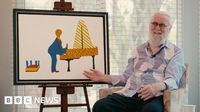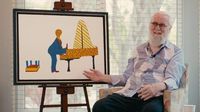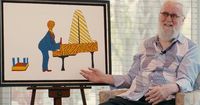Scottish comedy legend Sir Billy Connolly has once again captured the spotlight, but this time it’s with a paintbrush rather than a punchline. At 82 years old, Connolly has unveiled four new limited edition artworks under his celebrated Born On A Rainy Day series, released through Castle Fine Art on August 22, 2025. These pieces, bursting with color and wit, are more than just visual treats—they’re windows into the comedian’s most cherished memories, from rollicking tours with rock royalty to sunburned days in Scotland’s rare sunshine.
One artwork, in particular, has fans and art lovers talking. Titled Saturday Night, the piece features a flamboyant piano player mid-performance, his leg thrown dramatically onto the keyboard—a move Sir Billy describes as “pure Elton.” The inspiration? None other than Sir Elton John, the Rocket Man himself. Connolly fondly recalls his days opening for Elton during a 1976 tour of America. “It was that point of the show where he backheeled the stool and it tumbled off the stage. The roadies all dived so that it didn’t break,” Connolly told BBC Scotland News. The memory clearly still brings a smile to his face, as does Elton’s enduring talent. “I saw Elton lately and he was better than I’ve ever seen him. He’s an amazing performer.”
This isn’t the first time Connolly has drawn from his own life for artistic inspiration. Since retiring from comedy in 2018—a decision prompted by his Parkinson’s diagnosis in 2013—he’s poured his creative energy into art, music, and television. “Art is my life now,” he confided to BBC Scotland News. He began drawing in 2007, but it’s only in recent years that he’s felt comfortable calling his work “beautiful.” As he explained to the Daily Record, “It’s taken me years to call my art beautiful. I would never dream of saying it before for the chance that somebody would say, ‘it’s crap, you’re no good.’ But I’m quite good. I can make people smile and feel happy. It’s great.”
Saturday Night isn’t the only piece in the new collection with a personal backstory. Sausage Tree, another standout, is rooted in a memory from Connolly’s childhood. The drawing, which features a quirky tree with sausage-like pods, recalls a day spent driving through the Scottish countryside with his daughter, Amy. “We just went on the roads and saw things,” he reminisced in a BBC video. “Once we were near a place called Aberfoyle and we came upon a sausage tree.” It turned out to be a bush with unusual seed pods, but the name—and the memory—stuck.
Then there’s Sunburned, a humorous take on the Scottish relationship with the sun. The artwork shows a tartan-clad man whose skin is lobster red—a sight all too familiar to anyone who’s spent a rare sunny day north of Hadrian’s Wall. “When I did it I stood back and I thought ‘my god, you’ve got it,’” Connolly said to BBC Scotland News. “It’s the colour you go in Scotland when the sun shines on you. It’s weird. It’s not a sunbathing country, Scotland.” Still, Connolly’s affection for his homeland shines through. “Scotland is the most extraordinary country. It’s magical.”
The fourth piece, Fly Away Peter, is perhaps the most whimsical. It depicts a multicolored figure surrounded by birds, radiating a sense of joy and freedom that Connolly says reflects his own outlook. “I like things that make me smile,” he told Castle Fine Art. “I’m particularly pleased with the way I’ve drawn the stripes on the figure’s purple jacket and with the bird that peers over his shoulder.” For Connolly, the act of drawing is as much about spreading happiness as it is about self-expression.
Connolly’s transition from comedy to art hasn’t dulled his storytelling skills—if anything, it’s given them a new canvas. His works are hand-signed and available individually or as a set, exclusively through Castle Fine Art’s website and galleries. The launch was set for 8am BST on August 22, with eager collectors lining up for a piece of the beloved Scot’s imagination.
Even as he’s embraced his new artistic identity, Connolly hasn’t left fans behind. He’s continued to appear on television, with recent projects including Billy Connolly: Made In Scotland (2018), Billy Connolly’s Great American Trail (2019), and the ongoing Billy Connolly Does… series, which began airing in 2022. Despite the challenges of Parkinson’s disease, Connolly remains candid and upbeat about his health. In his 2024 book, The Accidental Artist, he wrote: “The Parkinson’s just rumbles along, doing its thing. It bothered me for a while but when I think about it I suppose I’m lucky I didn’t get something worse because I was a welder.”
That sense of gratitude and resilience is a thread running through both his art and his public life. Connolly has been open about the dangers he faced as a young shipyard welder in Glasgow, long before he found fame as a comedian and musician. “The diseases they talk about now due to welding weren’t known about when I was in the shipyards,” he wrote. “They didn’t know about the hazards of asbestos. And men were always dying in accidents too. I was in an accident myself. I fell off the ship into the Clyde, dropped 40 feet into three feet of water and broke my ankle.”
Not all the recent news has been positive, however. Earlier this month, Connolly issued a warning to fans about scammers impersonating him and his wife, Pamela Stephenson, online. Using artificial intelligence, these fraudsters have been reaching out to fans and soliciting direct messages, sometimes with criminal intent. “They could well be criminal,” Connolly cautioned, urging fans to stay vigilant and avoid falling victim to such schemes.
For all the ups and downs, Connolly’s creative journey continues to inspire. Whether he’s recalling the madcap energy of Elton John on stage, the innocent delight of a child spotting a “sausage tree,” or the peculiar pride of a sunburned Scotsman, his art is infused with humor, honesty, and a deep love for life’s oddities. As he told Castle Fine Art, “Throughout my career in music, comedy and art, one thing has remained with me—my profound ability as a storyteller.”
With his latest collection, Sir Billy Connolly proves that the stories don’t stop just because the stage lights have dimmed. They simply find new ways to shine.


